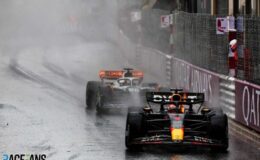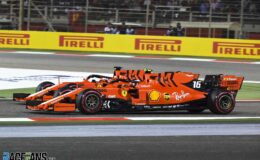
Formula 1’s new technical regulations for 2026 spells the end for the ‘ground effect’ era introduced just three years ago.
While the current generation of regulations was intended to create closer racing, and arguably has not succeeded, its replacement was designed around a new engine formula. This will see cars generate more of their power electrically.
Some have already warned this will have a negative effect on the racing. Red Bull team principal Christian Horner has predicted it will result in drivers slowing down and even dropping a gear on long straights on some circuits in order to maximise their energy recovery and deliver the fastest possible lap time.
Former Formula 1 test driver and Formula E racer Gary Paffett has shed new light on what next year’s grands prix could look like after driving a third-party simulation of a car designed to next year’s regulations. He suspects it could make F1 racing resemble what is seen in FE, where drivers tend to run close together early in the races to conserve their cars’ energy.
“If you get to a point where teams are using the amount of energy they’ve got available in different ways on different straights, then it could make a big difference,” Paffett explained in a video published by Canopy Simulations.
“In Formula E you have a point where you get a lot of lift-and-coasting, basically, to save energy. How your [engine] map is set up around the laps means that you’ll have strong areas and weak areas. And that could be the same thing: If teams have got their battery deployment in different areas then it could mean that there’s better overtaking opportunities.”
The simulation also indicated next year’s cars could lap within a second of current chassis. Paffett expects drivers will find the new car stronger on corner entries and weaker on exits.
Advert | Become a RaceFans supporter and
“Whereas the ’25 car has got really good grip and really good stability, sometimes it can be a bit lazy into the corners,” he said. “Whereas the ’26 car seems a bit more direct into the corners.
“For me the hardest thing to get used to with the ’26 car was the low-speed performance, especially on exits.”
“For me, the biggest difference and the biggest thing I struggled with with the new tyres, combined with the downforce, was just the low-speed,” Paffett explained. “So it’ll probably drive the teams towards looking at set-ups which improve traction, because it’s definitely going to be a limitation.
“Then if that’s still a problem, then during the races, drivers are really going to have to look after that side of things, not to overheat the tyres and get problems like that.
“Qualifying is going to be more difficult, I think, to nail a lap, because the car is just a bit more on the edge. But then into the race overheating the tyres is a massive thing. And especially now, even in the high speed corners when there’s less downforce, you’re stressing the tyres more and things like this.
“With the tyres being smaller, they’ll definitely take less load. So tyre wear and overheating and managing the tyres is definitely going to be a bigger topic in the ’26 car.”
Advert | Become a RaceFans supporter and
He predicted drivers will find next year’s cars more challenging to handle overall, which could also improve the racing.
“It was interesting after running the ’26 components and then going back to the ’25 car. It was a great car to drive because it was easy to drive. Then you change to the ’26 and suddenly it’s more of a challenge again.
“I think that’s what the fans want to see. The drivers are definitely going to be tested more than before and it also should make the actual racing more interesting.”
Get a daily email with all our latest stories – and nothing else. No marketing, no ads. Sign up here:
GÜNDEM
27 gün önceGÜNDEM
28 gün önceGÜNDEM
26 Ekim 2025GÜNDEM
26 Ekim 2025GÜNDEM
26 Ekim 2025GÜNDEM
26 Ekim 2025GÜNDEM
26 Ekim 2025GENEL
26 Ekim 2025 1
Ferrari struggling to recreate set-up which “worked well” in Shanghai – Hamilton | Formula 1
1128 kez okundu
1
Ferrari struggling to recreate set-up which “worked well” in Shanghai – Hamilton | Formula 1
1128 kez okundu
 2
Ayhancan Güven DTM’i Kazanan İlk Türk Pilot Oldu!
641 kez okundu
2
Ayhancan Güven DTM’i Kazanan İlk Türk Pilot Oldu!
641 kez okundu
 3
How will F1’s new Monaco tyre rule work – and how might teams try to exploit it? | Formula 1
392 kez okundu
3
How will F1’s new Monaco tyre rule work – and how might teams try to exploit it? | Formula 1
392 kez okundu
 4
The lesson from Leclerc’s years of radio frustrations: He must start calling the shots | Formula 1
274 kez okundu
4
The lesson from Leclerc’s years of radio frustrations: He must start calling the shots | Formula 1
274 kez okundu
 5
‘It’s very Hollywood, it’s for a broader audience’ – drivers’ views on ‘F1: The Movie’ | Formula 1
242 kez okundu
5
‘It’s very Hollywood, it’s for a broader audience’ – drivers’ views on ‘F1: The Movie’ | Formula 1
242 kez okundu